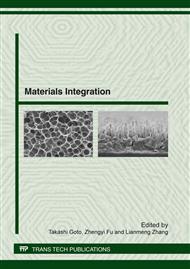p.300
p.304
p.310
p.315
p.325
p.331
p.341
p.347
p.353
Tantalum Vacancy Effects on Electrical Conductivity of La3Ta0.5Ga5.5O14 and Ba-Based P321 Crystals
Abstract:
Single Crystalline Langatate (La3Ta0.5Ga5.5O14, LTG) Has Been Widely Used in Piezoelectric Sensors for High Temperature Applications because of its Structural Stability at High Temperature. however, in the Recent Experiment, an Increase of Electrical Conductivity Has Been Also Observed at the Intermediate Temperature Region Ranges from 300 to 700°C. Also, in Theoretical Calculations, Penta-Valent Ta Vacancy Can Be Easily Generated and Influence Resistivity Degradation of the Crystal. In this Study, to Elucidate the Ta Vacancy Effects on Electrical Conductivity of LTG and Recently Proposed Ba-Based P321 Crystal such as BTGS and BTAS, Electrical Conductivity of those Materials Were Calculated and Compared by Utilizing Boltzmann Transport Theory. The Calculated GW Band Gaps of Perfect BTGS and BTAS (5.94 Ev and 6.69 Ev, Respectivily) Were much Larger than that of LTG (5.36 Ev). Also, at Intermediate Temperature (1000K), the Calculated Electrical Conductivity of LTG with V'''''Ta (in Kröger-Vink Notation [13]) Was around Twelve Times Higher than the Conductivity of BTGS and BTAS with Ta Vacancy.
Info:
Periodical:
Pages:
325-330
Citation:
Online since:
March 2012
Price:
Сopyright:
© 2012 Trans Tech Publications Ltd. All Rights Reserved
Share:
Citation:


